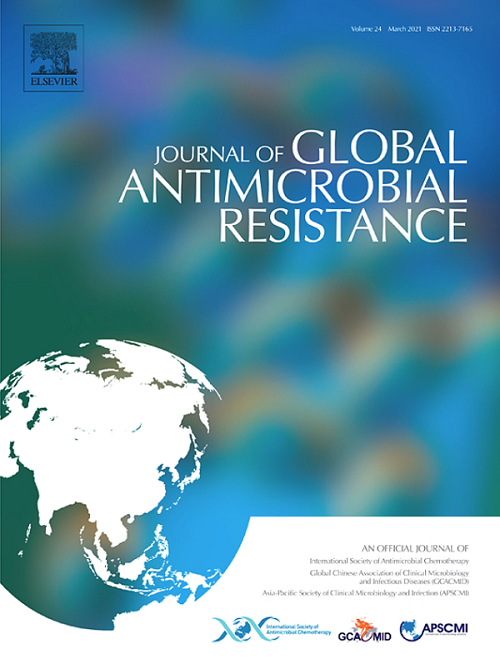Genomic insights of predominant international high-risk clone ST2 Acinetobacter baumannii isolates in Saudi Arabia
IF 3.7
3区 医学
Q2 INFECTIOUS DISEASES
引用次数: 0
Abstract
Objectives
Carbapenem-resistant Acinetobacter baumannii (CRAB), particularly the globally prevalent ST2 clone, poses significant threats in the Gulf Cooperation Council region through extensive drug resistance, high virulence, and efficient gene transfer. This study investigates the epidemiological and genomic characteristics of CRAB in the Jazan region, using whole genome sequencing to understand its transmission and genetic determinants.
Methods
Sixty-five clinical A. baumannii isolates exhibiting phenotypic resistance to carbapenems (meropenem, imipenem, and ertapenem) were collected from various tertiary hospitals in the Jazan region. The presence of prevalent carbapenemase genes among these isolates was examined using two sets of multiplex polymerase chain reaction (PCR). Forty-eight isolates confirmed as carbapenemase producers were selected for WGS analysis.
Results
Among the 65 clinical CRAB isolates, the adult ICU exhibited the highest prevalence of CRAB (76.9%). Multiplex PCR identified 48 (73.8%) isolates as carbapenemase producers, all harboring blaOXA-51-like genes. Specifically, blaOXA-23 was detected in 39 isolates (60%), blaNDM in 8 (12.3%), and blaOXA-24 in one isolate. These 48 carbapenemase-producing isolates also carried virulence-associated genes related to adherence, biofilm formation, immune evasion, iron acquisition and regulation, and serum resistance. Whole-genome sequencing (WGS) revealed that 39 (81.2%) of the carbapenemase-positive isolates belonged to ST2, followed by ST85 and ST107, with the KL152 locus as the most common capsule type.
Conclusions
The study indicates a significant rise in the ST2 clone in the Arabian Gulf, particularly in Saudi Arabia, and underscores the need for ongoing surveillance of less common clones such as ST85 and ST107 to manage public health risks effectively.
沙特阿拉伯主要国际高危克隆ST2鲍曼不动杆菌分离株的基因组见解。
目的:耐碳青霉烯鲍曼不动杆菌(CRAB),特别是全球流行的ST2克隆,通过广泛的耐药、高毒力和高效的基因转移,对海湾合作委员会地区构成重大威胁。本研究利用全基因组测序技术,研究了吉赞地区螃蟹的流行病学和基因组特征,以了解其传播和遗传决定因素。方法:从吉山地区各三级医院收集65株对碳青霉烯类药物(美罗培南、亚胺培南、厄他培南)表现表型耐药的鲍曼不雅杆菌。利用两组多重聚合酶链反应(PCR)检测了这些分离株中普遍存在的碳青霉烯酶基因。筛选出48株碳青霉烯酶产生菌进行WGS分析。结果:65株临床分离株中,以成人ICU感染率最高(76.9%)。多重PCR鉴定出48株碳青霉烯酶产生菌(73.8%),均含有blaoxa -51样基因。其中,blaOXA-23检出39株(60%),blaNDM检出8株(12.3%),blaOXA-24检出1株。这48株产碳青霉烯酶的分离株还携带与粘附、生物膜形成、免疫逃避、铁获取和调节以及血清抗性相关的毒力相关基因。全基因组测序结果显示,39株(81.2%)碳青霉烯酶阳性菌株属于ST2,其次是ST85和ST107,其中KL152位点为最常见的荚膜类型。结论:该研究表明,在阿拉伯湾,特别是在沙特阿拉伯,ST2克隆显著增加,并强调需要持续监测ST85和ST107等不太常见的克隆,以有效管理公共卫生风险。
本文章由计算机程序翻译,如有差异,请以英文原文为准。
求助全文
约1分钟内获得全文
求助全文
来源期刊

Journal of global antimicrobial resistance
INFECTIOUS DISEASES-PHARMACOLOGY & PHARMACY
CiteScore
8.70
自引率
2.20%
发文量
285
审稿时长
34 weeks
期刊介绍:
The Journal of Global Antimicrobial Resistance (JGAR) is a quarterly online journal run by an international Editorial Board that focuses on the global spread of antibiotic-resistant microbes.
JGAR is a dedicated journal for all professionals working in research, health care, the environment and animal infection control, aiming to track the resistance threat worldwide and provides a single voice devoted to antimicrobial resistance (AMR).
Featuring peer-reviewed and up to date research articles, reviews, short notes and hot topics JGAR covers the key topics related to antibacterial, antiviral, antifungal and antiparasitic resistance.
 求助内容:
求助内容: 应助结果提醒方式:
应助结果提醒方式:


